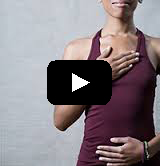|
Advanced Yoga Practices Plus Lesson 41 - Spinal Breathing Pranayama (Audio)
For Lesson Additions join
AYP Plus Dec 11, 2003
Sit comfortably with back support, and close your eyes just as you do when you meditate. Now, keeping your mouth closed, breathe in and out slowly and deeply through your nose, but not to the extreme. Be relaxed and easy about it, breathing as slowly and deeply as possible without discomfort. There is no need to be heroic. Work your muscles so each breath begins in your belly and fills you up through your chest to the top of your collarbones, and then comes back down slowly. Next, with each rising inhalation of the breath, allow your attention to travel upward inside a tiny thread, or tube, you visualize beginning at your perineum, continuing up through the center of your spine, and up through the stem of your brain to the center of your head. At the center of your head the tiny nerve makes a turn forward to the point between your eyebrows. With one slow, deep inhalation let your attention travel gradually inside the nerve from the perineum all the way to the point between the eyebrows. As you exhale, retrace this path from the point between the eyebrows all the way back down to the perineum. Then, come back up to the point between the eyebrows with the next inhalation, and down to the perineum with the next exhalation, and so on.
In a week or so, or whenever you are feeling steady with the ten minutes of pranayama before your meditation, add the following features: On the exhalations, allow your epiglottis to close enough so that there is a small restriction of the air leaving your lungs. This is called "ujjayi." The epiglottis is the door in your throat that automatically closes your windpipe (trachea) when you hold your breath or swallow. By partially closing it as you exhale, a fine hissing sound will occur in your throat. Be easy about it. Don't strain. Keep the slow, deep rhythm of breathing you have become accustomed to as you add this small restriction in the throat during exhalations. On the inhalations, allow the throat to relax and open more than usual. Do not restrict the air coming in. Rather, allow the deepest part of your throat to open wide, comfortably. Do not change the slow, deep rhythm of breathing you have been doing. Keep your mouth closed during pranayama. An exception would be if your nose is stopped up and you can't breath easily through it. In that case, use your mouth.
This pranayama will quiet the nervous system, and provide a fertile ground for deep meditation. With this beginning in spinal breathing, we are also laying the foundation for additional practices that will greatly enhance the flow of prana in the body. Once we have stabilized the practices we have learned so far, we will be ready to begin gently awakening the huge storehouse of prana near the base of our spine. Note: See Lesson Addition 239.1 for clarifications and enhancements for spinal breathing pranayama practice.
Spinal Breathing Related Lessons Topic Path Discuss this Lesson in the AYP Plus Support Forum Note: For detailed instructions on spinal breathing, see the Spinal Breathing Pranayama Online Book.
|
|

